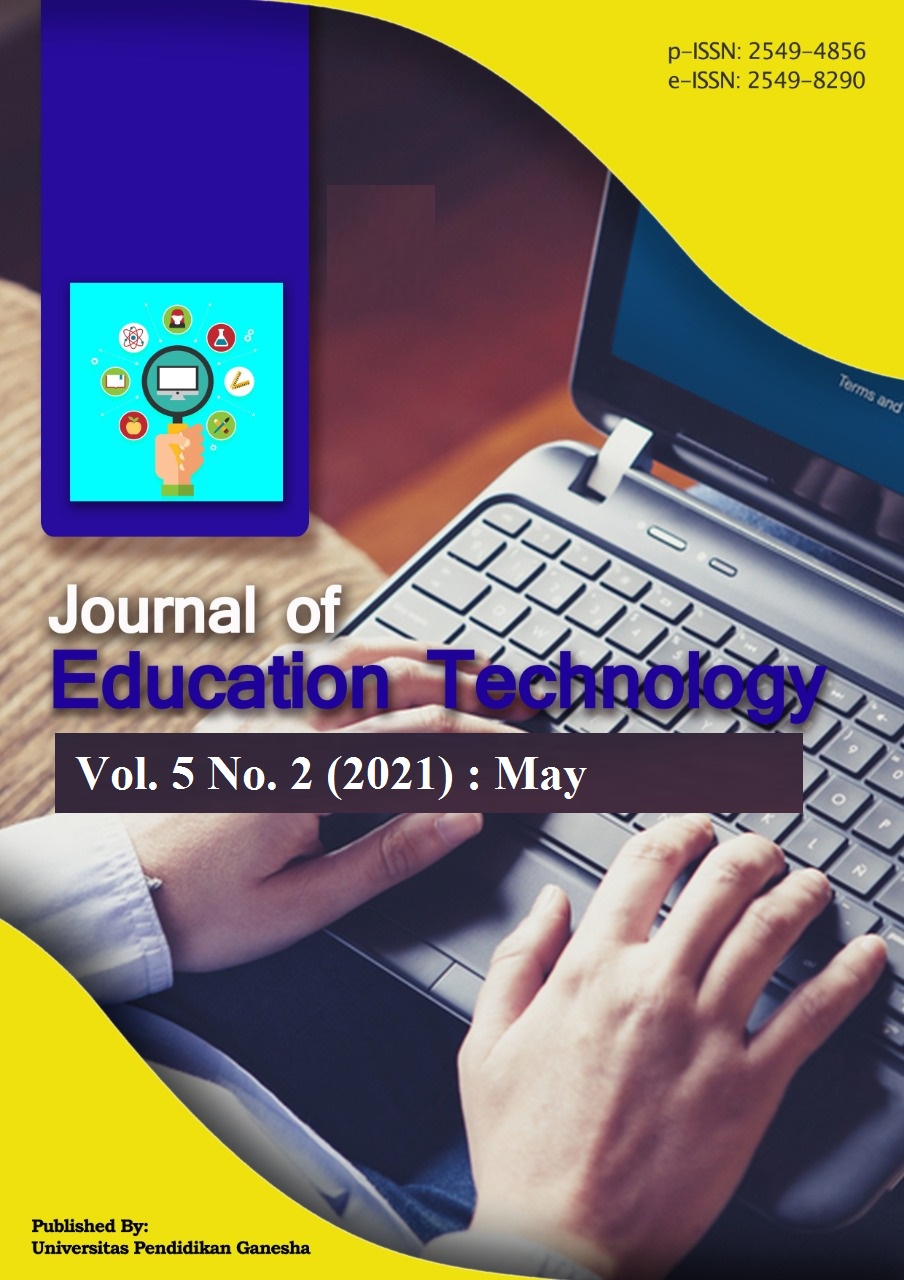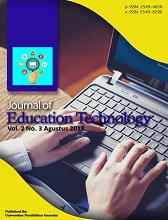“English First” APK for Facilitating Autonomous Screenagers
DOI:
https://doi.org/10.23887/jet.v5i2.32758Keywords:
“English Firstâ€, autonomous learners, digital natives, Intensive English CourseAbstract
Digital native or screenagers cannot be separated from technology in their education and entertainment (edutainment). That phenomenon gives them an opportunity to be autonomous learners. Regarding the principle of autonomous learners, this study was aimed at developing an Android Package Kit (APK) smartphone application as learning media for facilitating screenagers. A research and development design comprising need analysis, design, and development was employed during the study. Freshmen year of English Language Education who attended English Intensive Course (IEC) were involved in the study. The data were collected through students’ interview guide, document analysis, expert judgment rubrics, and a questionnaire. The result showed that the freshmen year needed innovative, challenging, and fun English learning media in the course. In addition, the application was developed based on five topics found in the document analysis, namely “Meeting at the Campus”, “What You Are Wearing”, “Directions”, “Weather”, and “Necessity and Obligation”. From the result of the expert judgment, the learning media were considered excellent. Both learners and lecturers in this digital era should consider the needs of utilizing technology in teaching and learning process specifically for facilitating autonomous learners.References
Al Zieni, H. (2019). The effect of mobile learning on learner autonomy: A suggested measurement tool to assess the development of learner autonomy. The Journal of Asia TEFL, 16(3), 1020–1031. https://doi.org/10.18823/asiatefl.2019.16.3.19.1020.
Alqahtani, M. (2015). The importance of vocabulary in language learning and how to be taught. International Journal of Teaching and Education, III(3), 21–34. https://doi.org/10.20472/TE.2015.3.3.002.
Alsaadat, K. (2017). Mobile learning technologies. International Journal of Electrical and Computer Engineering, 7(5), 2833–2837. https://doi.org/10.11591/ijece.v7i5.pp2833-2837.
Alzieni, H. (2019). The effect of mobile learning on learner autonomy: A suggested measurement tool to assess the development of learner autonomy. Journal of Asia TEFL, 16(3), 1020–1031. https://doi.org/10.18823/asiatefl.2019.16.3.19.1020.
Alzieni, H. (2021). The Impact of Mobile-Assisted Language Learning (MALL) in Developing the Listening Skill: A Case of Students at Dubai Men’s College, the United Arab Emirates. Arab World English Journal, 2, 84–95. https://doi.org/10.24093/awej/mec2.6.
Begum, J. (2018). Learner autonomy in efl/esl classrooms in bangladesh: Teachers’ perceptions and practices. International Journal of Language Education, 2(2), 96–104. https://doi.org/10.26858/ijole.v2i2.6411.
Benson, P. (2001). Teaching and researching: Autonomy in language learning (2nd ed.). Longman.
Benson, P., & Voller, P. (1997). Autonomy and independence in language learning. Longman.
ÇAKICI, D. (2015). Autonomy in Language Teaching and Learning Process. İnönü Üniversitesi Eğitim Fakültesi Dergisi, 16(1). https://doi.org/10.17679/iuefd.16168538.
Choi, H., & Lee, C. H. (2020). Learner autonomy in EFL reading with digital technology at secondary school level. The Journal of Asia TEFL, 17(4), 1323–1345.
Cojocnean, D. (2017). Mobile learning in the foreign language classroom – Challenges and opportunities. Journal of Pedagogy, LXV(1), 59–72. https://doi.org/10.26755/revped/2017.1/59.
Coman, C., Țîru, L. G., Meseșan-Schmitz, L., Stanciu, C., & Bularca, M. C. (2020). Online teaching and learning in higher education during the coronavirus pandemic: Students’ perspective. Sustainability (Switzerland), 12(24), 1–22. https://doi.org/10.3390/su122410367.
Criollo-C, S., Guerrero-Arias, A., Jaramillo-Alcázar, Á., & Luján-Mora, S. (2021). Mobile learning technologies for education: Benefits and pending issues. Applied Sciences (Switzerland), 11(9). https://doi.org/10.3390/app11094111.
Dong, C., & Liu, X. (2013). Development of android application for language studies. Procedia IERI, 4, 8–16. https://doi.org/10.1016/j.ieri.2013.11.003.
Economides, A. A. (2009). Requirements of mobile learning applications. International Journal of Innovation and Learning, 5(5), 457–479.
Foti, M. K., & Mendez, J. (2014). Mobile Learning: How Students Use Mobile Devices to Support Learning. Journal of Literacy and Technology, 15(3).
Ghavifekr, S., & Rosdy, W. A. W. (2015). Teaching and learning with technology: Effectiveness of ICT integration in schools. International Journal of Research in Education and Science, 1(2), 175–191. https://doi.org/10.21890/ijres.23596.
Gregory, R. J. (2014). Psychological Testing: History, Principles, and Applications (7th Ed.). Pearson Education Limited.
Howard, J., & Major, J. (2004). Guidelines for designing effective English language teaching materials. Procedia - Social and Behavioral Sciences, 101–109.
Jelisaveta, Š. (2013). Strategies of learning English as a foreign language at Faculty of Technical Sciences. Procedia - Social and Behavioral Sciences, 93, 775–782. https://doi.org/10.1016/j.sbspro.2013.09.278.
Louis, R. St. (2005). Helping students become autonomous learners: Can technology help? Webheads in Action Online Convergence, 1–26.
Ma, J. (2017). Design and implementation of mobile learning system for soldiers’ vocational skill identification based on android. IOP Conference Series: Materials Science and Engineering, 242(1–4). https://doi.org/10.1088/1757-899X/242/1/012119.
Masouleh, N. S., & Jooneghani, R. B. (2012). Autonomous learning: A teacher-less learning! Procedia - Social and Behavioral Sciences, 55, 835–842. https://doi.org/10.1016/j.sbspro.2012.09.570.
Mejía, G. (2016). Promoting language learning: The use of mLearning in the Spanish classes. Revista de Lenguas Para Fines Específicos, 22(1), 80–99. https://doi.org/10.20420/rlfe.2016.305.
Melvina, Lengkanawati, N. S., & Wirza, Y. (2021). The Use of Technology to Promote Learner Autonomy in Teaching English. Proceedings of the Thirteenth Conference on Applied Linguistics (CONAPLIN 2020), 546(Conaplin 2020), 315–321. https://doi.org/10.2991/assehr.k.210427.048.
Novitasari, K. (2019). Penggunaan Teknologi Multimedia Pada Pembelajaran Literasi Anak Usia Dini. Jurnal Golden Age, 3(01), 50. https://doi.org/10.29408/goldenage.v3i01.1435.
Nurkancana, W., & Sunartana, P. (1992). Evaluasi hasil belajar. Usaha Nasional.
Ozdamli, F., & Cavus, N. (2011). Basic elements and characteristics of mobile learning. Procedia - Social and Behavioral Sciences, 28, 937–942. https://doi.org/10.1016/j.sbspro.2011.11.173.
Rimale, Z., Benlahmar, E. H., Tragha, A., & El Guemmat, K. (2016). Survey on the use of the mobile learning based on mobile cloud computing. International Journal of Interactive Mobile Technologies, 10(3), 35–41. https://doi.org/10.3991/ijim.v10i3.5672.
Robert Maribe Branch. (2009). Intructional Design: The ADDIE Approach. Springer.
Rock, T. C., & Wilson, C. (2005). Improving teaching through lesson study. Teacher Education Quarterly, Winter 2005, 77–92.
Sarrab, M., Elgamel, L., & Aldabbas, H. (2012). Mobile Learning (M-Learning) and Educational Environments. International Journal of Distributed and Parallel Systems (IJDPS), 3(4), 31–38.
Tayebinik, M., & Puteh, M. (2012). Mobile learning to support teaching English as a second language. Journal of Education and Practice, 3(7), 56–63.
Tracy, K. W. (2015). Mobile Application Development Experiences on Apple’s iOS and Android OS (Issue December). https://doi.org/10.1109/mpot.2011.2182571.
Uswatun, H. (2013). Autonomous Learning As Language Learning Strategy Based on Students Preferenced Learning Style. IDEAS: Journal on English Language Teaching and Learning, Linguistics and Literature, 1(2), 1–22. http://ejournal.iainpalopo.ac.id/index.php/ideas/article/view/163.
Wang, B.-T. (2017). Designing mobile apps for English vocabulary learning. International Journal of Information and Education Technology, 7(4), 279–283. https://doi.org/10.18178/ijiet.2017.7.4.881.
Wu, Q. (2014). Learning ESL vocabulary with smartphones. Procedia - Social and Behavioral Sciences, 143(June), 302–307. https://doi.org/10.1016/j.sbspro.2014.07.409.
Yoon, S. Y., Lee, J., & Lee, C. H. (2013). Interacting with screenagers in classrooms. Procedia - Social and Behavioral Sciences, 103, 534–541. https://doi.org/10.1016/j.sbspro.2013.10.370.
Yuwono, M. R. (2016). Analisis Kesulitan Mahasiswa dalam Menyelesaikan Soal Geometri Berdasarkan Taksonomi Bloom dan Alternatif Pemecahannya. Beta Jurnal Tadris Matematika, 9(2), 111. https://doi.org/10.20414/betajtm.v9i2.7.
Downloads
Published
How to Cite
Issue
Section
License
Authors who publish with the Journal of Education Technology agree to the following terms:
- Authors retain copyright and grant the journal the right of first publication with the work simultaneously licensed under a Creative Commons Attribution License (CC BY-SA 4.0) that allows others to share the work with an acknowledgment of the work's authorship and initial publication in this journal.
- Authors are able to enter into separate, additional contractual arrangements for the non-exclusive distribution of the journal's published version of the work (e.g., post it to an institutional repository or publish it in a book), with an acknowledgment of its initial publication in this journal.
- Authors are permitted and encouraged to post their work online (e.g., in institutional repositories or on their website) prior to and during the submission process, as it can lead to productive exchanges, as well as earlier and greater citation of published work. (See The Effect of Open Access)


















